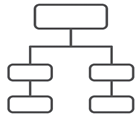Web Development and Design Process
Our tried and true design and development approach helps ensure success on your project!
WATERFALL MODEL
The Waterfall Model is the earliest method of structured system development, and the simplest software development life cycle (SDLC) model. It is a sequential development process, in which development is seen as flowing steadily downwards (like a waterfall) through the phases of requirements analysis, design, implementation, testing (validation), integration, and maintenance.
 1. REQUIREMENTS
1. REQUIREMENTS
This phase is critical to the success of a software project. Reason? While customers typically have at least a rough idea of what they want as an end result, they are not too sure about what the software they want developed should do. That’s where requirements analysis comes in. It is the process of understanding the customer needs and expectations from a proposed system or application and is a well-defined stage in the Software Development Life Cycle model. Requirements generated from the requirements analysis stage come in handy for: project scoping, cost estimating and budgeting, project scheduling, and software design, testing.
 2. DESIGN & ARCHITECTURE
2. DESIGN & ARCHITECTURE
This stage comes immediately after the software requirements have been frozen; a stage where the actual design of the system is done. . During this phase, the development team prepares the functional specifications, database structure, flow diagrams, and defines the modules. In most cases a ppt/html screen prototype of the new system can also be developed. This allows the customer to review the future system and to give their feedback at an early stage of the development. Like every other phase, the design phase ends with verification of the design
 3. IMPLEMENTATION
3. IMPLEMENTATION
Designs are translated into code in this phase. Computer programs are written using a conventional programming language or an application generator. Various programming tools are used to generate the code and the coding itself is done using different high level programming languages.
 4. TESTING
4. TESTING
Testing is an integral and important part of the software development process. This part of the process ensures that bugs are recognized as early as possible. Different testing methodologies are employed to unravel the bugs that were committed during the previous
 5. MAINTENANCE
5. MAINTENANCE
The maintenance phase involves making changes to hardware, software, and documentation to support its operational effectiveness. It includes making changes to improve a system’s performance, correct problems, enhance security, or address user requirements.
ITERATIVE & INCREMENTAL
Iterative and Incremental development model is a cyclic software development process that can be used as an alternative to the Waterfall model. The model does not do away with the need for analysis, design, implementation and testing activities that are intrinsic to the Waterfall model, but these are carried out in a more flexible manner. Each iteration includes some or most of the development disciplines (requirements, analysis, design, implementation, and so on). Each iteration also has a well-defined set of objectives and produces a partial working implementation of the final system. And each successive iteration builds on the work of previous iterations to evolve and refine the system until the final product is complete.
 INITIAL PLANNING
INITIAL PLANNING
Designs are translated into code in this phase. Computer programs are written using a conventional programming language or an application generator. Various programming tools are used to generate the code and the coding itself is done using different high level programming languages.
 PLANNING
PLANNING
Designs are translated into code in this phase. Computer programs are written using a conventional programming language or an application generator. Various programming tools are used to generate the code and the coding itself is done using different high level programming languages.
 REQUIREMENTS
REQUIREMENTS
This phase is critical to the success of a software project. Reason? While customers typically have at least a rough idea of what they want as an end result, they are not too sure about what the software they want developed should do. That’s where requirements analysis comes in. It is the process of understanding the customer needs and expectations from a proposed system or application and is a well-defined stage in the Software Development Life Cycle model. Requirements generated from the requirements analysis stage come in handy for: project scoping, cost estimating and budgeting, project scheduling, and software design, testing.
 ANALYSIS & DESIGN
ANALYSIS & DESIGN
This phase is critical to the success of a software project. Reason? While customers typically have at least a rough idea of what they want as an end result, they are not too sure about what the software they want developed should do. That’s where requirements analysis comes in. It is the process of understanding the customer needs and expectations from a proposed system or application and is a well-defined stage in the Software Development Life Cycle model. Requirements generated from the requirements analysis stage come in handy for: project scoping, cost estimating and budgeting, project scheduling, and software design, testing.
 IMPLEMENTATION
IMPLEMENTATION
This phase is critical to the success of a software project. Reason? While customers typically have at least a rough idea of what they want as an end result, they are not too sure about what the software they want developed should do. That’s where requirements analysis comes in. It is the process of understanding the customer needs and expectations from a proposed system or application and is a well-defined stage in the Software Development Life Cycle model. Requirements generated from the requirements analysis stage come in handy for: project scoping, cost estimating and budgeting, project scheduling, and software design, testing.
 DEPLOYMENT
DEPLOYMENT
This phase is critical to the success of a software project. Reason? While customers typically have at least a rough idea of what they want as an end result, they are not too sure about what the software they want developed should do. That’s where requirements analysis comes in. It is the process of understanding the customer needs and expectations from a proposed system or application and is a well-defined stage in the Software Development Life Cycle model. Requirements generated from the requirements analysis stage come in handy for: project scoping, cost estimating and budgeting, project scheduling, and software design, testing.
 EVALUATION
EVALUATION
This phase is critical to the success of a software project. Reason? While customers typically have at least a rough idea of what they want as an end result, they are not too sure about what the software they want developed should do. That’s where requirements analysis comes in. It is the process of understanding the customer needs and expectations from a proposed system or application and is a well-defined stage in the Software Development Life Cycle model. Requirements generated from the requirements analysis stage come in handy for: project scoping, cost estimating and budgeting, project scheduling, and software design, testing.
 TESTING
TESTING
This phase is critical to the success of a software project. Reason? While customers typically have at least a rough idea of what they want as an end result, they are not too sure about what the software they want developed should do. That’s where requirements analysis comes in. It is the process of understanding the customer needs and expectations from a proposed system or application and is a well-defined stage in the Software Development Life Cycle model. Requirements generated from the requirements analysis stage come in handy for: project scoping, cost estimating and budgeting, project scheduling, and software design, testing.
